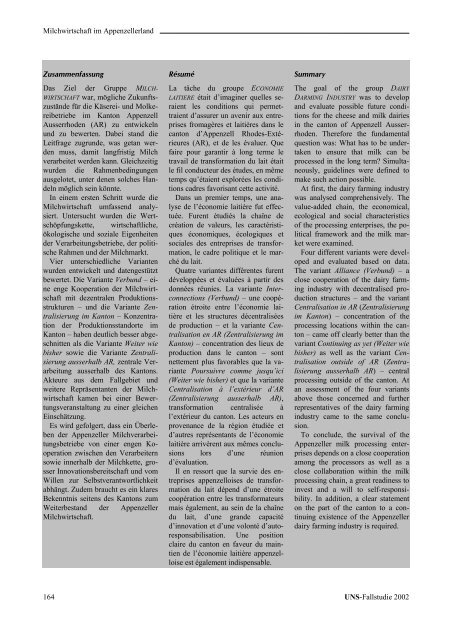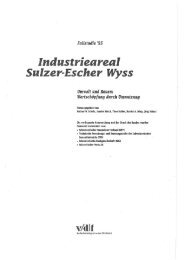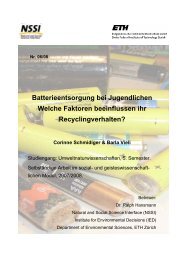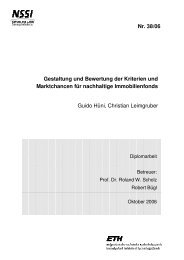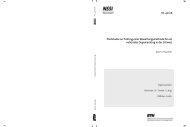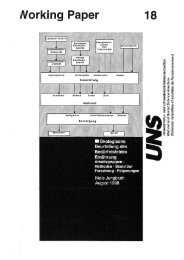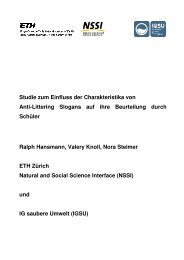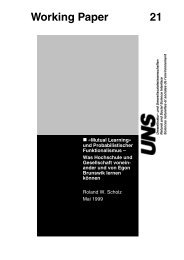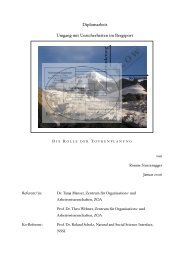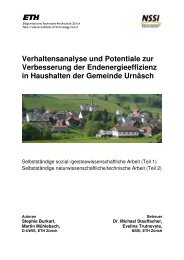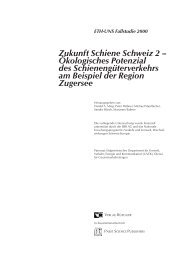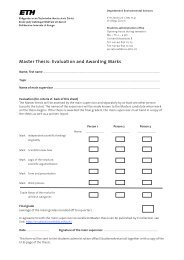Appenzell Ausserrhoden - ETH Zurich - Natural and Social Science ...
Appenzell Ausserrhoden - ETH Zurich - Natural and Social Science ...
Appenzell Ausserrhoden - ETH Zurich - Natural and Social Science ...
Sie wollen auch ein ePaper? Erhöhen Sie die Reichweite Ihrer Titel.
YUMPU macht aus Druck-PDFs automatisch weboptimierte ePaper, die Google liebt.
Milchwirtschaft im <strong>Appenzell</strong>erl<strong>and</strong><br />
Zusammenfassung<br />
Das Ziel der Gruppe MILCH-<br />
WIRTSCHAFT war, mögliche Zukunftszustände<br />
für die Käserei- und Molkereibetriebe<br />
im Kanton <strong>Appenzell</strong><br />
<strong>Ausserrhoden</strong> (AR) zu entwickeln<br />
und zu bewerten. Dabei st<strong>and</strong> die<br />
Leitfrage zugrunde, was getan werden<br />
muss, damit langfristig Milch<br />
verarbeitet werden kann. Gleichzeitig<br />
wurden die Rahmenbedingungen<br />
ausgelotet, unter denen solches H<strong>and</strong>eln<br />
möglich sein könnte.<br />
In einem ersten Schritt wurde die<br />
Milchwirtschaft umfassend analysiert.<br />
Untersucht wurden die Wertschöpfungskette,<br />
wirtschaftliche,<br />
ökologische und soziale Eigenheiten<br />
der Verarbeitungsbetriebe, der politische<br />
Rahmen und der Milchmarkt.<br />
Vier unterschiedliche Varianten<br />
wurden entwickelt und datengestützt<br />
bewertet. Die Variante Verbund – eine<br />
enge Kooperation der Milchwirtschaft<br />
mit dezentralen Produktionsstrukturen<br />
– und die Variante Zentralisierung<br />
im Kanton – Konzentration<br />
der Produktionsst<strong>and</strong>orte im<br />
Kanton – haben deutlich besser abgeschnitten<br />
als die Variante Weiter wie<br />
bisher sowie die Variante Zentralisierung<br />
ausserhalb AR, zentrale Verarbeitung<br />
ausserhalb des Kantons.<br />
Akteure aus dem Fallgebiet und<br />
weitere Repräsentanten der Milchwirtschaft<br />
kamen bei einer Bewertungsveranstaltung<br />
zu einer gleichen<br />
Einschätzung.<br />
Es wird gefolgert, dass ein Überleben<br />
der <strong>Appenzell</strong>er Milchverarbeitungsbetriebe<br />
von einer engen Kooperation<br />
zwischen den Verarbeitern<br />
sowie innerhalb der Milchkette, grosser<br />
Innovationsbereitschaft und vom<br />
Willen zur Selbstverantwortlichkeit<br />
abhängt. Zudem braucht es ein klares<br />
Bekenntnis seitens des Kantons zum<br />
Weiterbest<strong>and</strong> der <strong>Appenzell</strong>er<br />
Milchwirtschaft.<br />
Résumé<br />
La tâche du groupe ECONOMIE<br />
LAITIERE était d’imaginer quelles seraient<br />
les conditions qui permettraient<br />
d’assurer un avenir aux entreprises<br />
fromagères et laitières dans le<br />
canton d’<strong>Appenzell</strong> Rhodes-Extérieures<br />
(AR), et de les évaluer. Que<br />
faire pour garantir à long terme le<br />
travail de transformation du lait était<br />
le fil conducteur des études, en même<br />
temps qu’étaient explorées les conditions<br />
cadres favorisant cette activité.<br />
Dans un premier temps, une analyse<br />
de l’économie laitière fut effectuée.<br />
Furent étudiés la chaîne de<br />
création de valeurs, les caractéristiques<br />
économiques, écologiques et<br />
sociales des entreprises de transformation,<br />
le cadre politique et le marché<br />
du lait.<br />
Quatre variantes différentes furent<br />
développées et évaluées à partir des<br />
données réunies. La variante Interconnections<br />
(Verbund) – une coopération<br />
étroite entre l’économie laitière<br />
et les structures décentralisées<br />
de production – et la variante Centralisation<br />
en AR (Zentralisierung im<br />
Kanton) – concentration des lieux de<br />
production dans le canton – sont<br />
nettement plus favorables que la variante<br />
Poursuivre comme jusqu’ici<br />
(Weiter wie bisher) et que la variante<br />
Centralisation à l’extérieur d’AR<br />
(Zentralisierung ausserhalb AR),<br />
transformation centralisée à<br />
l’extérieur du canton. Les acteurs en<br />
provenance de la région étudiée et<br />
d’autres représentants de l’économie<br />
laitière arrivèrent aux mêmes conclusions<br />
lors d’une réunion<br />
d’évaluation.<br />
Il en ressort que la survie des entreprises<br />
appenzelloises de transformation<br />
du lait dépend d’une étroite<br />
coopération entre les transformateurs<br />
mais également, au sein de la chaîne<br />
du lait, d’une gr<strong>and</strong>e capacité<br />
d’innovation et d’une volonté d’autoresponsabilisation.<br />
Une position<br />
claire du canton en faveur du maintien<br />
de l’économie laitière appenzelloise<br />
est également indispensable.<br />
Summary<br />
The goal of the group DAIRY<br />
DARMING INDUSTRY was to develop<br />
<strong>and</strong> evaluate possible future conditions<br />
for the cheese <strong>and</strong> milk dairies<br />
in the canton of <strong>Appenzell</strong> <strong>Ausserrhoden</strong>.<br />
Therefore the fundamental<br />
question was: What has to be undertaken<br />
to ensure that milk can be<br />
processed in the long term? Simultaneously,<br />
guidelines were defined to<br />
make such action possible.<br />
At first, the dairy farming industry<br />
was analysed comprehensively. The<br />
value-added chain, the economical,<br />
ecological <strong>and</strong> social characteristics<br />
of the processing enterprises, the political<br />
framework <strong>and</strong> the milk market<br />
were examined.<br />
Four different variants were developed<br />
<strong>and</strong> evaluated based on data.<br />
The variant Alliance (Verbund) – a<br />
close cooperation of the dairy farming<br />
industry with decentralised production<br />
structures – <strong>and</strong> the variant<br />
Centralisation in AR (Zentralisierung<br />
im Kanton) – concentration of the<br />
processing locations within the canton<br />
– came off clearly better than the<br />
variant Continuing as yet (Weiter wie<br />
bisher) as well as the variant Centralisation<br />
outside of AR (Zentralisierung<br />
ausserhalb AR) – central<br />
processing outside of the canton. At<br />
an assessment of the four variants<br />
above those concerned <strong>and</strong> further<br />
representatives of the dairy farming<br />
industry came to the same conclusion.<br />
To conclude, the survival of the<br />
<strong>Appenzell</strong>er milk processing enterprises<br />
depends on a close cooperation<br />
among the processors as well as a<br />
close collaboration within the milk<br />
processing chain, a great readiness to<br />
invest <strong>and</strong> a will to self-responsibility.<br />
In addition, a clear statement<br />
on the part of the canton to a continuing<br />
existence of the <strong>Appenzell</strong>er<br />
dairy farming industry is required.<br />
164 UNS-Fallstudie 2002


